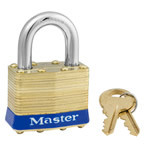Most people think that Marine Locks would be locks that are used in and around boats and marinas. That would be correct; however, Marine Locks, due to their construction, can be used anywhere that moisture is a problem. So what makes a lock a Maine Lock? Can these locks have high security features? I will try to answer these and other questions.

Die Cast Locks
Let’s start with the construction, these locks are made of brass, die cast alloy or stainless steel. Before I continue when I say locks it could mean padlocks, cam locks and door locks. Padlocks would be made typically of brass or stainless steel. The shackles would be a hardened steel that is plated for rust protection or stainless steel. The internal parts are usually brass or stainless steel. Any of these construction materials could have high security features. Abloy is a well-known manufacturer that specializes in high security padlocks for extreme environmental conditions.
Door locks are either die cast alloy or brass. Either one would also have rust inhibiting plating. The internal workings would either be brass or stainless steel. You will find that Marine Door Locks are available in knob style and deadbolt style. Electronic locks are now starting to find their way into the marine security industry.
Cam locks would also be made of either a plated zinc-alloy or plated brass. The plating on these locks would also be available in different plating colors to blend into the décor. Cam Locks would come in a wide variety of security levels, depending on what you are trying to protect and secure.

Brass
Laminated Padlocks
f you are using these locks in or around salt water make sure that they have some resistance to salt water spray. Some manufacturers will seek out UL certification which will include some type of salt water spray testing. Locks in salt water applications should have this certification.
Just by their very nature Marine Locks will need a higher level of maintenance. You should follow the manufacturer’s recommendation on the type of lubrication and cleaner that should be used. This includes both the inside and outside of the lock. If the inside of the locks is not maintained it will quickly become “frozen”. This happens when moisture enters the lock, it will attract dust and dirt which will eventually cause the lock to become inoperable. In salt water areas corrosion could occur due to the salt spray attacking the metal or brass parts.
For additional information please visit: LockingSystems.com